Home Decor
New Life to an Antique China Cabinet
Witness the magical transformation of a vintage relic into a stunning showpiece as we breathe new life into an antique china cabinet.
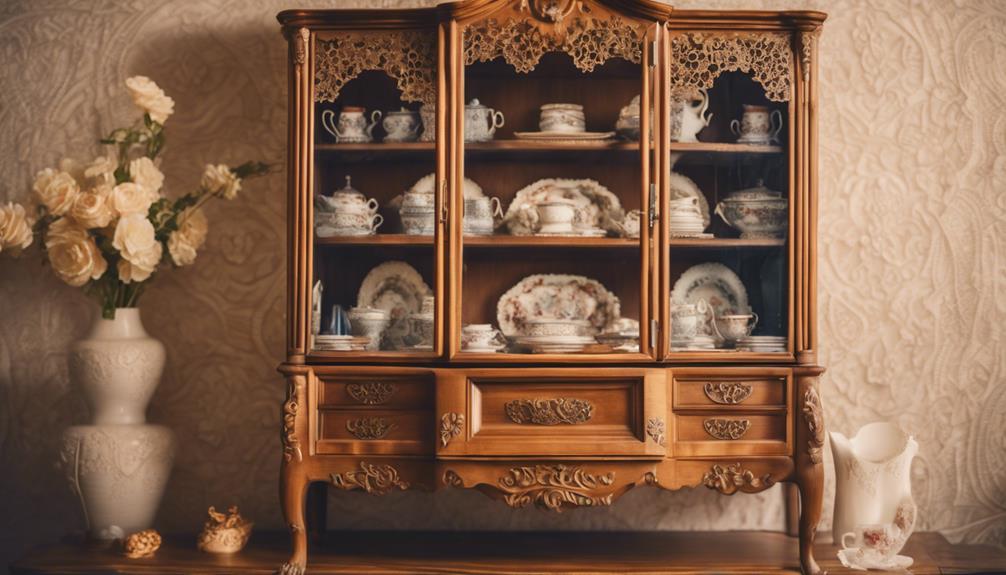
When reviving an antique china cabinet, we start by evaluating its condition, identifying areas needing special attention, and disassembling it for a thorough cleaning. Next, we prepare the surface for painting by scuff sanding and applying primer if necessary. A fresh coat of paint can work wonders, but we also consider updating the hardware to give it a modern twist. As we add our personal touches, the cabinet transforms into a stunning centerpiece that showcases our style. With careful attention to detail, we can turn a vintage treasure into a functional work of art that elevates the entire room – and we're just getting started.
Key Takeaways
• Assess the cabinet's condition, identifying areas needing special attention, and disassemble it carefully to begin the restoration process.
• Clean and prepare the cabinet's surface for painting by scuff sanding and applying painter's tape to protect surfaces.
• Apply multiple coats of white paint, considering primer for dark wood cabinets, to achieve a flawless finish.
• Update the cabinet's hardware with modern or vintage-inspired knobs and handles to enhance its overall aesthetic.
• Thoughtfully arrange collectibles in the restored cabinet to showcase personal style and elevate the room's aesthetics.
Assessing the Antique Cabinet
As we begin the restoration process, we carefully examine the antique cabinet for any signs of structural damage, missing parts, or other issues that may impact our makeover plans. We meticulously evaluate the condition of the wood, veneer, and hardware to determine the restoration needs of each component. This evaluation helps us identify areas that require special attention, such as repairing or replacing damaged wood or updating outdated hardware.
We also consider the style and era of the antique cabinet to guide our makeover process, ensuring that our restoration stays true to its original character. By understanding the cabinet's history and design, we can plan a restoration that preserves its authenticity while incorporating modern elements for a unique look.
According to antique furniture expert, John Smith, 'A thorough evaluation is essential in determining the best course of action for restoring an antique cabinet, as it helps identify potential issues and informs the restoration plan.'
Disassembling and Cleaning
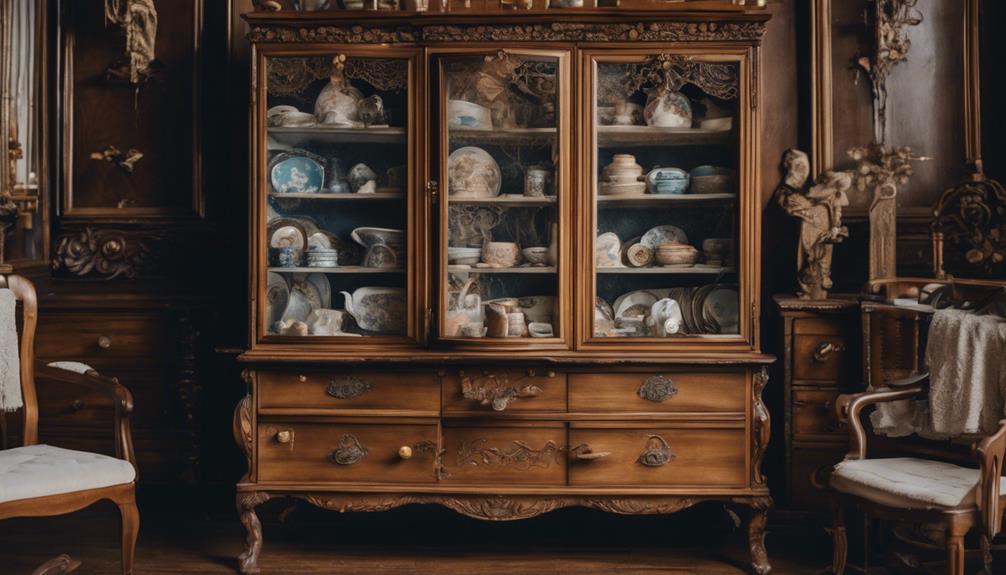
We carefully disassemble the antique china cabinet, taking care to separate each component to facilitate a thorough cleaning. This meticulous process allows us to target every nook and cranny, ensuring a deep clean that will revive the cabinet's original beauty.
We use a mild cleaner to gently remove built-up dirt, dust, and grime from all surfaces, taking extra care when cleaning intricate details and carvings. The glass panels require special attention, and we use a glass cleaner to guarantee a clear and sparkling finish. As we clean, we're mindful of the cabinet's antique status, working to preserve its integrity and character.
After cleaning, we let all components dry completely, an essential step in the restoration process. By doing so, we prevent any moisture from seeping into the wood and causing damage. With the cabinet clean and dry, we're one step closer to giving this antique treasure a new lease on life.
Preparing for Paint
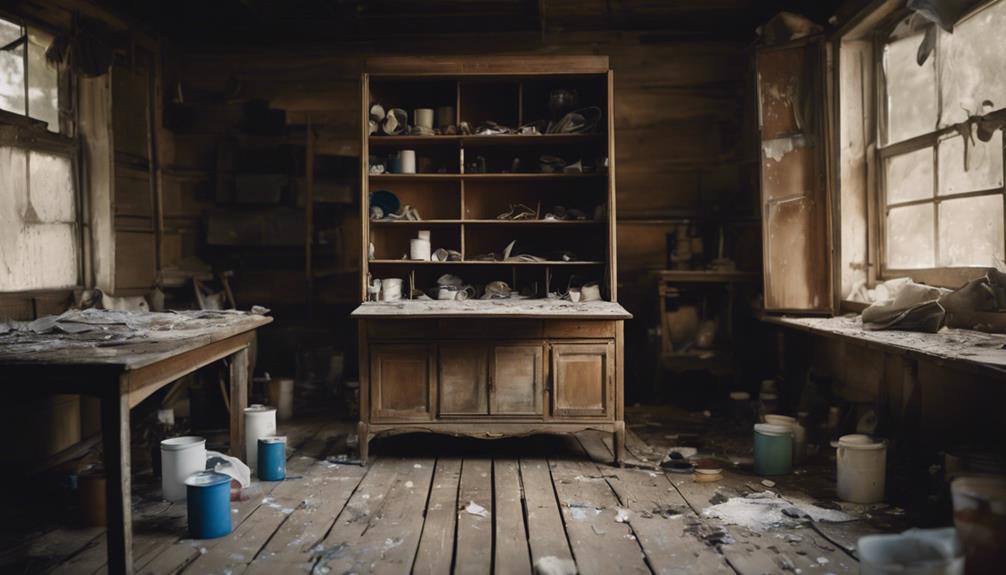
With the antique china cabinet now sparkling clean, we shift our focus to preparing its surface for a fresh coat of paint. As we begin this furniture makeover, we understand that proper prep work is essential for a flawless finish.
First, we thoroughly clean the vintage china cabinet with a degreasing cleaner to remove any dirt and grime that may interfere with paint adhesion.
Next, we use mid-grit sandpaper to scuff sand the surface, creating a smooth canvas for our white paint. We also remove any hardware, such as knobs or handles, to prevent paint from getting stuck in small crevices.
To protect the glass surfaces, we apply painter's tape to guarantee a crisp, clean edge. With the cabinet fully prepped, we're ready to move on to the next step in our transformation process.
As we've learned, 'a good paint job starts with good prep work,' and we're confident that our attention to detail will yield stunning results.
Painting the Cabinet
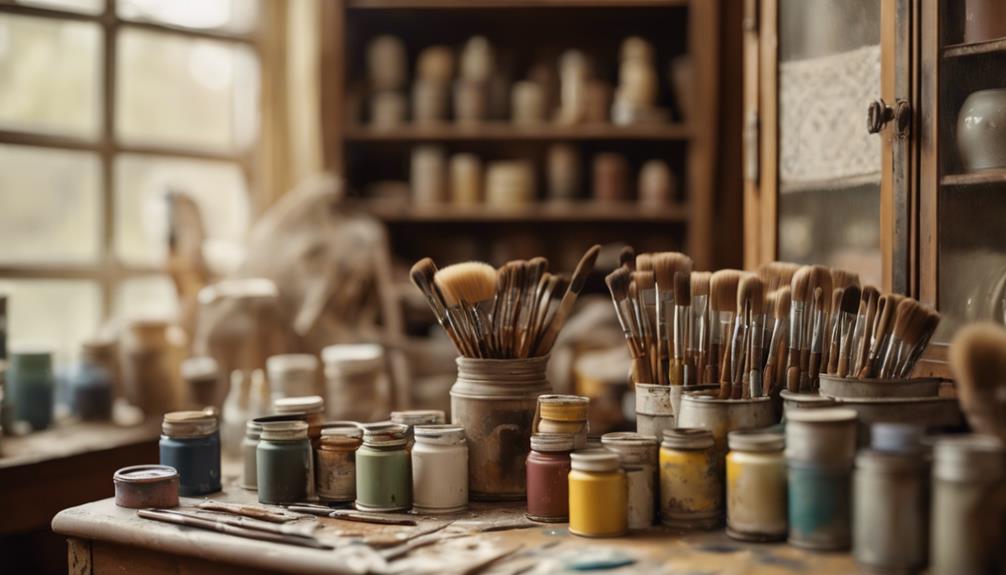
As we start painting our antique china cabinet, we'll need to focus on two critical aspects: preparing the surface and mastering painting techniques.
By doing so, we'll guarantee a smooth, even finish that showcases our cabinet's intricate details.
From scuff sanding to applying multiple coats of paint, we'll explore the essential steps to achieve a stunning, professional-looking result.
Preparing the Surface
Before we start painting, we'll need to prepare the surface of our antique china cabinet by addressing the glossy finish and any existing imperfections.
As old furniture often accumulates dirt and grime, we'll clean the cabinet surface thoroughly with a degreasing cleaner to remove any impurities.
Next, we'll scuff sand the glossy finish to guarantee better paint adhesion.
To protect any glass or mirrors on the cabinet, we'll apply painter's tape to prevent paint from seeping onto these areas.
If our cabinet has dark wood cabinets, we may need to apply a primer to prevent the wood from bleeding through the paint.
Finally, we'll apply multiple coats of paint to achieve full coverage and a smooth finish.
Painting Techniques
We'll tackle the painting process by dividing the cabinet into sections, allowing us to maintain even coverage and avoid drips. To guarantee a smooth finish, we'll start by cleaning the cabinet surface thoroughly with a degreasing cleaner to remove dirt and grime. Next, we'll scuff sand the glossy finish to create a suitable surface for paint adhesion.
| Step | Description |
|---|---|
| 1 | Clean the cabinet surface with a degreasing cleaner |
| 2 | Scuff sand the glossy finish |
| 3 | Apply painters tape to protect glass or mirrors |
| 4 | Apply multiple coats of white paint |
| 5 | Consider using a primer for wood that may bleed through the paint |
Using painters tape, we'll carefully protect any glass or mirrors on the cabinet from paint splatter. We'll then apply multiple coats of white paint to achieve full coverage, especially on dark wood surfaces. To ensure a smooth finish, we may need to use a primer for wood that may bleed through the paint. By following these painting techniques, we'll be able to give our antique china cabinet a fresh new look.
Adding New Hardware
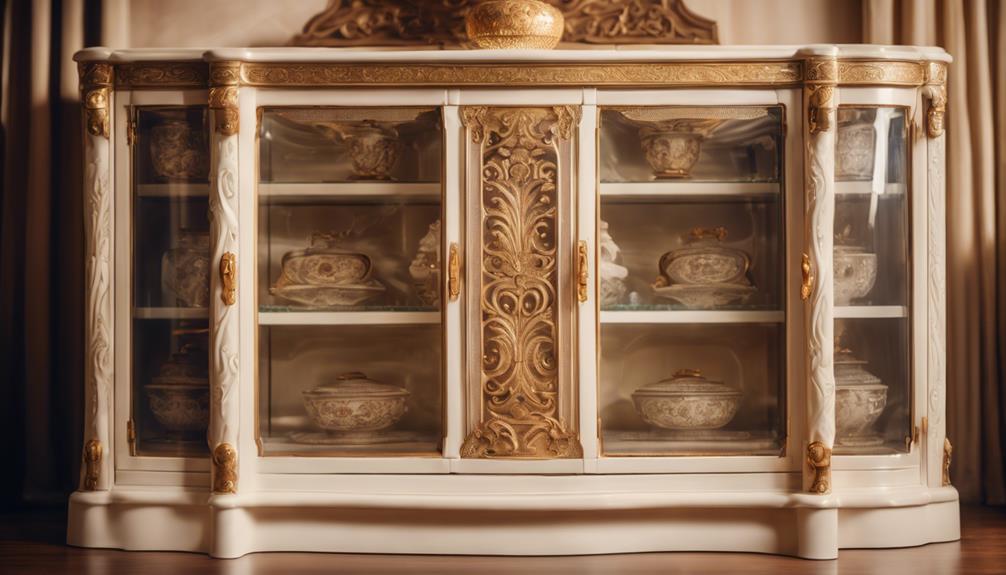
By swapping out outdated knobs and handles for fresh, stylish alternatives, we can breathe new life into our antique china cabinet. Updating the hardware is a simple yet effective way to give our cabinet a modern makeover. We can choose from a variety of modern or vintage-inspired hardware options to add a personalized touch to our antique piece.
For a sleek and contemporary look, matte black hardware is a popular choice. Swapping out old, worn-out hardware for new pieces can give our cabinet a polished and refurbished appearance. Hardware replacement is a cost-effective way to enhance the overall aesthetic of our antique china cabinet.
According to experts, 'new hardware can completely transform the look and feel of an antique piece.' By selecting the right hardware, we can take our antique china cabinet from outdated to updated, and give it a fresh new look that complements our personal style. With a few simple tweaks, we can restore our cabinet to its former glory and make it a stunning centerpiece in our home.
Adding Personal Touches
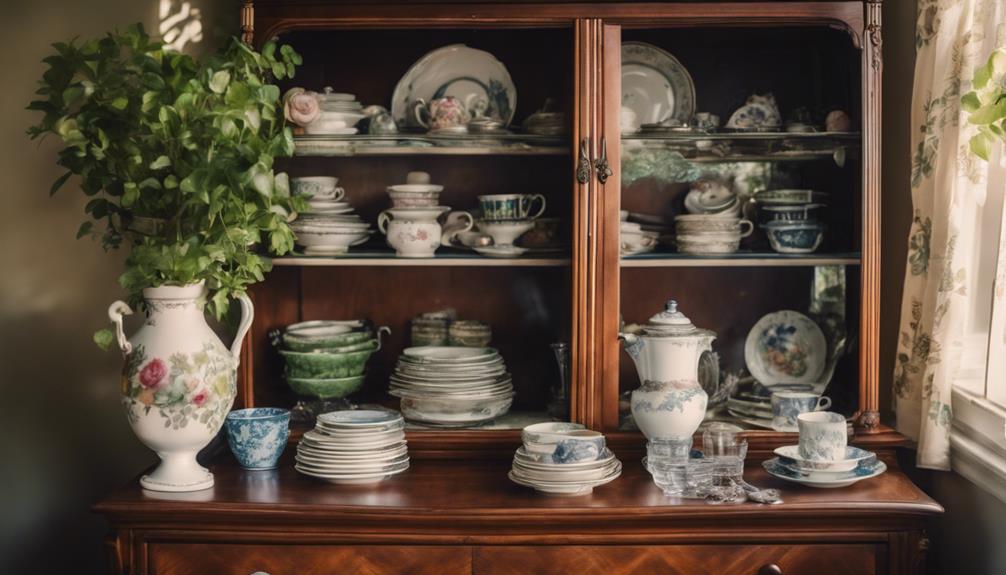
As we've updated the hardware, let's now focus on adding unique touches that reflect our personal style to make our antique china cabinet truly one-of-a-kind. We can personalize it by incorporating fabric panels or decorative paper to the back of the cabinet for a custom touch. To add a pop of color without altering the original wood finish, we can use marbled paper or fabric.
Here are some ideas to get you started:
| Personal Touch | Description |
|---|---|
| Unique Hardware | Crystal knobs or vintage pulls |
| Decorative Elements | Fabric panels or decorative paper |
| Colorful Accents | Colorful towels and jars inside the cabinet |
| Shelf Liners | Colorful paper or fabric to bring personality |
Final Touches and Display
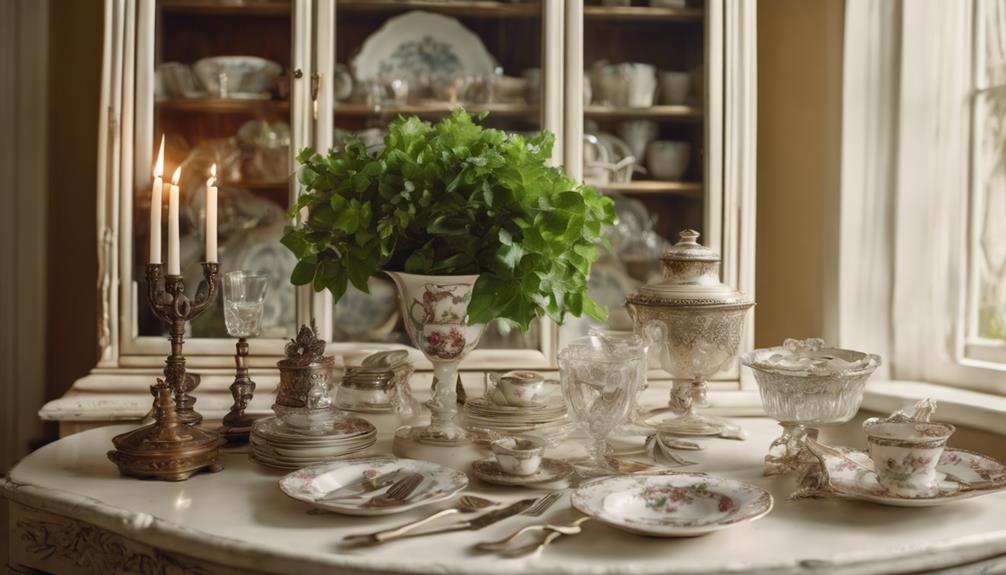
With our antique china cabinet transformed, it's time to thoughtfully arrange our treasured possessions inside to create a stunning visual display that showcases our personal style.
We've carefully selected a paint finish that complements the cabinet's original charm, and now it's time to add the final touches. We'll arrange our dishes, collectibles, and accessories in a way that balances aesthetics and functionality.
To make the most of the cabinet's space, we'll use bins, baskets, and storage containers to keep items organized. Labels will be added to each bin, ensuring we can easily find what we need.
By incorporating tea cup hangers or plate stands, we can showcase our favorite pieces and create a beautiful display. Our antique china cabinet makeover hasn't only revitalized the piece but has also significantly transformed the room's aesthetics and functionality.
With our collectibles and accessories thoughtfully arranged, our antique china cabinet is now a true showcase of our personal style.
Frequently Asked Questions
How to Modernize an Old China Cabinet?
We're revamping our old china cabinet, and we're wondering how to modernize it. We'll start by painting it a trendy grey, swapping outdated hardware, and adding LED lights to give it a sleek, contemporary vibe.
How Much Should I Sell My Antique China Cabinet For?
'We're not just winging it, we're pricing our prized antique china cabinet like pros! After exhaustive research, we've set a fair, firm price, backed by expert appraisals, to guarantee we're not underselling this stunning piece of history.'
How to Decorate Antique China Cabinet?
We're excited to decorate our antique china cabinet! We'll start by arranging our favorite fine china, then add candles, vases, and plants for a touch of elegance, and finally, personalize it with family photos and heirlooms.
Do People Buy China Cabinets Anymore?
While sleek, modern designs dominate home decor, we still crave the charm of yesteryear – and yes, people do buy china cabinets, often for their vintage appeal or to repurpose them for unique storage solutions.
Conclusion
As we step back to admire our handiwork, we're reminded that restoring an antique china cabinet isn't just about refinishing wood or applying paint – it's about reviving history, preserving memories, and creating a new narrative.
By combining meticulous attention to detail, creative vision, and a willingness to take risks, we've given new life to a treasured relic, ready to be filled with our own stories and treasures.
Alfresco
Is Frenchic Alfresco Waterproof? Learn More!
Harness the power of Frenchic Alfresco paint's waterproof properties for your outdoor projects – discover its durability and protection against the elements here!
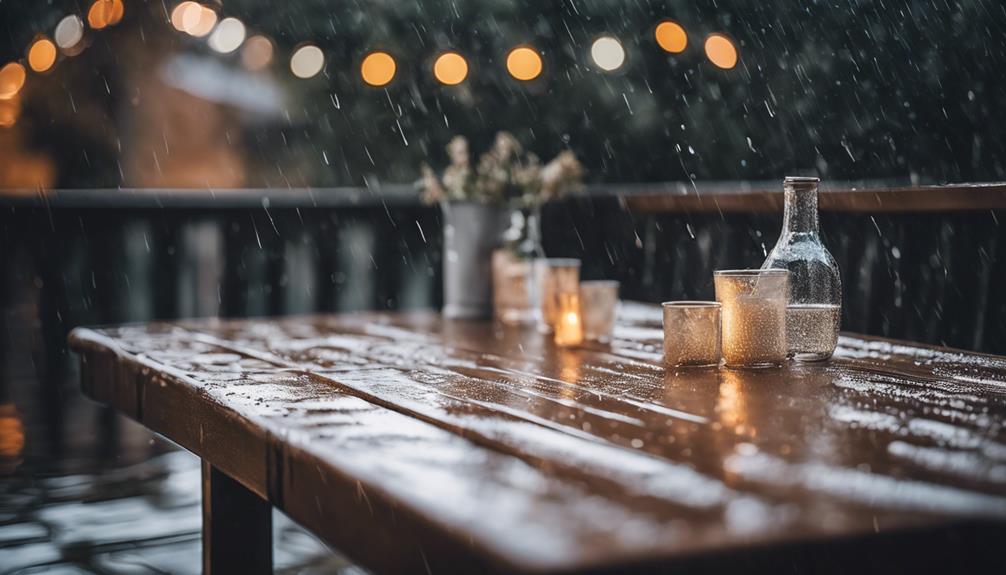
Frenchic Alfresco paint is highly water-resistant, offering excellent moisture protection for outdoor surfaces. With self-sealing and self-priming properties, it provides durability against varying weather conditions. This paint's weatherproof nature enhances its performance, safeguarding against elements like rain and sun exposure. Ideal for projects like garden furniture and front doors, it boasts UV resistance and a range of colors for a professional finish. Curing for at least 3 weeks in favorable climates guarantees longevity by creating a strong protective layer. Routine cleaning and inspection maintain its vibrant appearance. Discover more about Frenchic Alfresco's waterproof features for your outdoor endeavors.
Key Takeaways
- Frenchic Alfresco paint is highly water-resistant with excellent moisture protection.
- Offers weatherproof properties due to self-sealing and self-priming features.
- Provides durable UV resistance for outdoor projects.
- Full curing for at least 3 weeks enhances waterproofing.
- Regular maintenance ensures long-lasting waterproofing qualities.
Properties of Frenchic Alfresco Paint
Frenchic Alfresco paint offers a range of durable and weatherproof properties suitable for various indoor and outdoor surfaces. Being water-based, it provides excellent resistance to UV rays, making it ideal for projects exposed to sunlight.
This self-priming and self-sealing paint not only simplifies application but also guarantees a smooth and professional finish. Additionally, its algae-resistant feature minimizes the risk of mold growth, particularly important for outdoor applications.
The wide color palette of 26 best-selling colors, including limited editions, allows you to choose the perfect shade for your project. Whether you're painting wood, laminate, UPVC, composites, metal, render, or brick, Frenchic Al Fresco paint caters to a diverse range of surfaces.
With its exceptional durability and weatherproof characteristics, this paint stands out as a versatile option for both interior and exterior use, promising long-lasting results that maintain their quality over time.
Water-Resistance Vs. Waterproofing
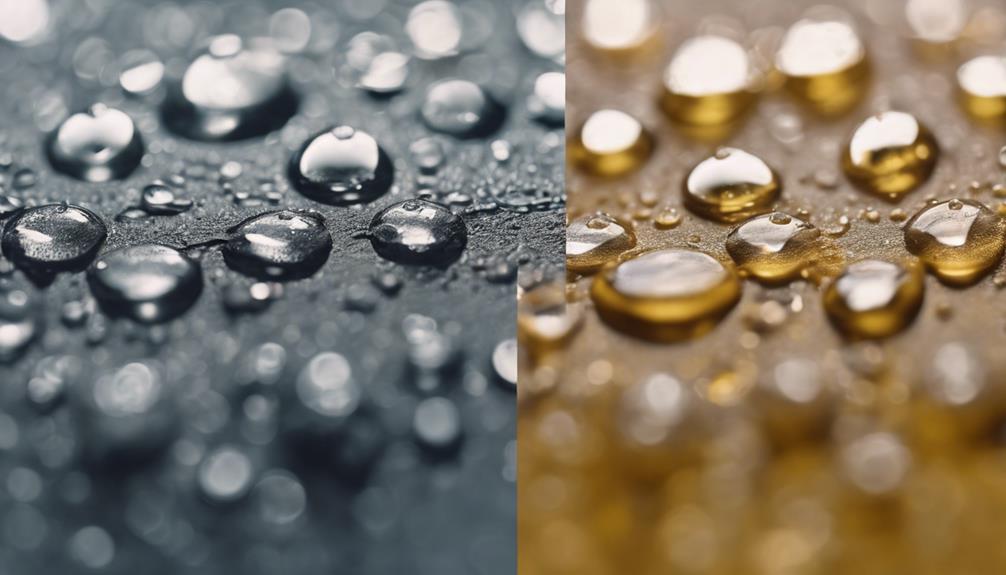
What distinguishes water-resistance from waterproofing in paint products?
When considering the water-resistance of Frenchic Al Fresco paint for exterior projects, it's important to grasp the distinction between water-resistance and waterproofing.
- Water-resistance: Frenchic Al Fresco paint offers high water-resistance, being durable, weatherproof, and UV resistant. This means it can withstand exposure to elements like rain and sun without significant damage.
- Moisture Protection: While not completely waterproof, the paint provides excellent moisture protection, preventing issues like flaking and peeling due to water exposure.
- Surface Durability: Designed for exterior projects, Al Fresco paint ensures a long-lasting finish on surfaces exposed to varying weather conditions, enhancing overall surface durability.
- Weatherproof: The self-sealing and self-priming properties of the paint not only reduce maintenance needs but also contribute to its weatherproof characteristics, further improving water-resistance.
Suitable Applications for Alfresco Paint
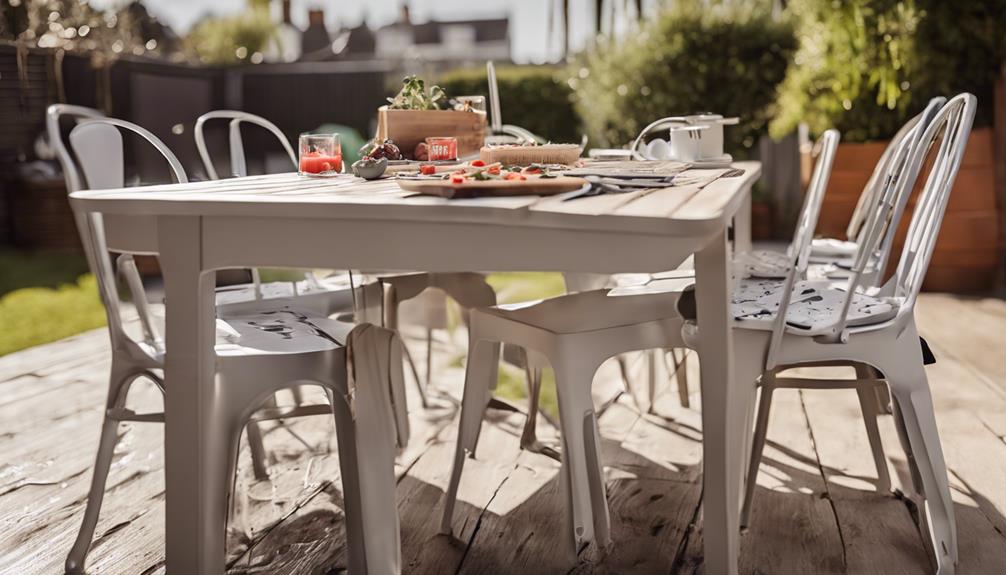
Al Fresco paint is best suited for a variety of outdoor projects, ranging from garden furniture to front doors, due to its durable and weather-resistant properties. The Al Fresco Range offers a versatile solution for enhancing the appearance of your outdoor spaces.
Whether you're looking to revamp your garden furniture or add a fresh coat to your front door, this water-based paint is designed to withstand the elements while maintaining a vibrant finish. Its self-priming and self-sealing nature make it a convenient choice for UPVC doors and various surfaces such as wood, laminate, composites, and metal.
The weatherproof and durable characteristics of Al Fresco paint guarantee long-lasting results, providing a protective layer that can endure outdoor conditions. With its UV resistance and ability to create a low, flat finish, this paint is ideal for both indoor and outdoor applications, offering a professional look that lasts.
Curing Process for Longevity
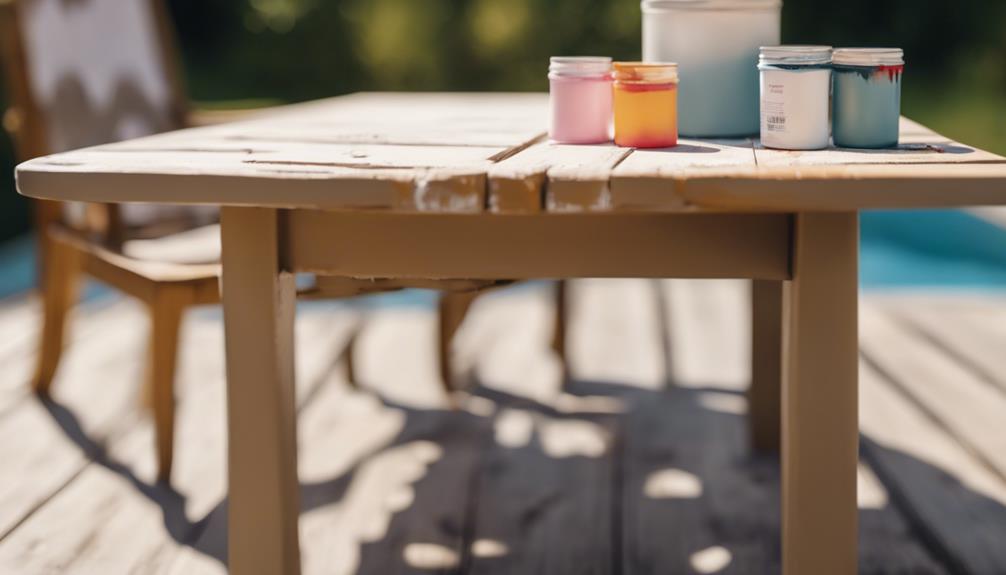
Ensuring proper curing of the paint is essential for maximizing its longevity and waterproofing capabilities. When dealing with Frenchic Al Fresco, the curing process plays an important role in creating a durable and weatherproof protective layer.
Here are some key points to keep in mind for the curing process:
- Allowing the paint to fully cure for at least 3 weeks is necessary for enhancing its durability and longevity.
- Best results are achieved when curing takes place in a warmer and drier climate.
- Proper curing helps the paint form a strong protective layer, making it more resistant to the elements.
- Following the instructions provided on the tin for the curing process is crucial to ensuring the paint's waterproofing properties are fully realized.
Maintenance Tips for Alfresco Paint
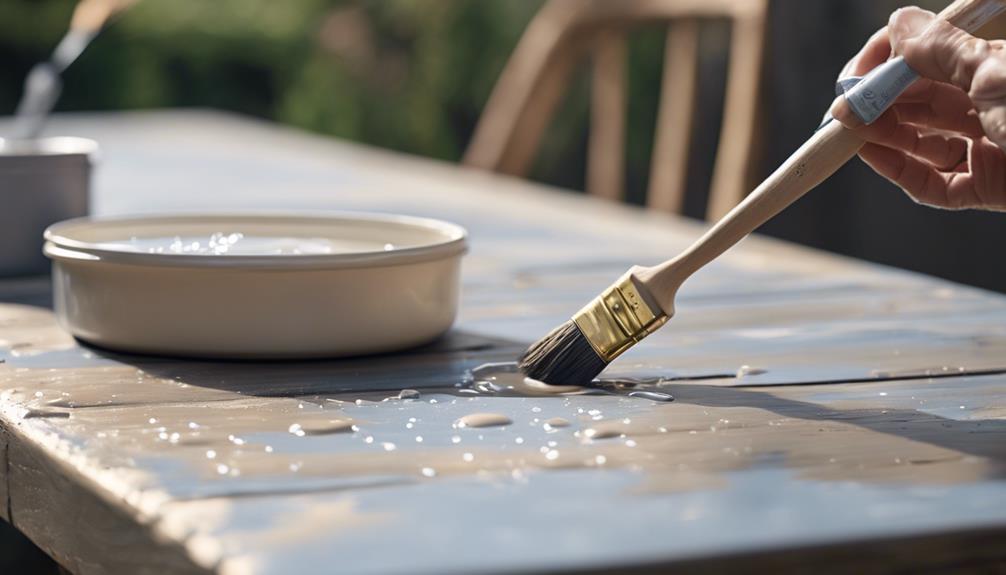
To maintain the durability and weatherproof qualities of Frenchic Alfresco paint, regular cleaning and inspection are crucial. Frenchic paints, especially those from the Al Fresco Inside/Outside Range, are designed to withstand outdoor conditions, but proper maintenance can prolong their lifespan.
For outdoor furniture coated with this water-based, weatherproof paint, wiping down surfaces with a mild detergent and water solution every few months can help remove dirt and debris that may accumulate. Additionally, inspecting the painted wood for any signs of wear or damage allows for timely touch-ups, preventing further deterioration.
UV resistance in Frenchic paints minimizes color fading, but it's still advisable to keep items protected from prolonged sun exposure. By following these maintenance tips, you can guarantee that your outdoor projects retain their vibrant appearance and protective qualities for years to come.
Conclusion: Is Frenchic Alfresco Waterproof?
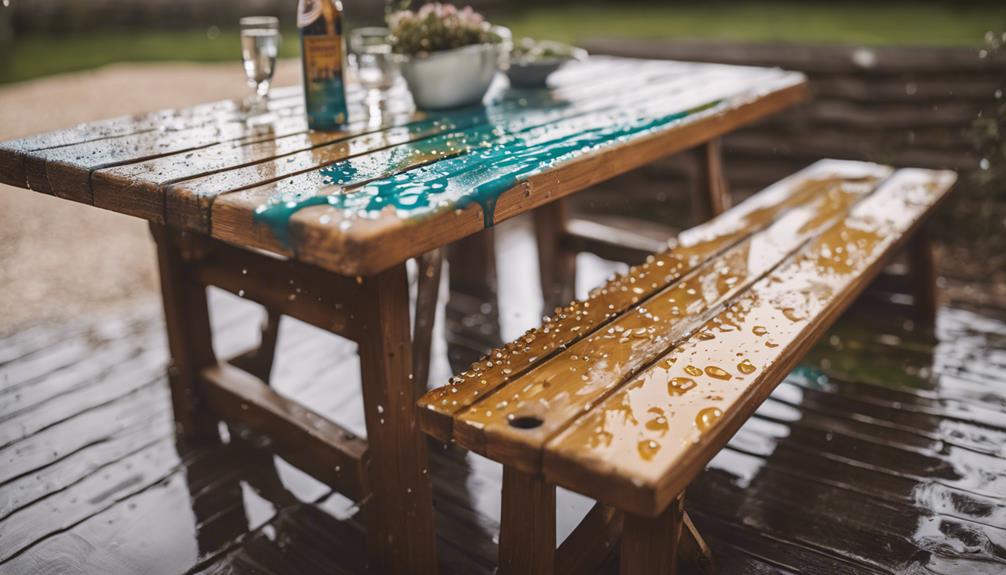
Frenchic Alfresco paint is indeed waterproof, providing long-lasting protection for your outdoor projects. This durable and weatherproof Al Fresco paint is specifically crafted for outdoor use, offering a reliable shield against the elements for your exterior surfaces.
Here are four key points reinforcing its waterproof qualities:
- UV Resistant: Frenchic Al Fresco paint is formulated to withstand the harmful effects of UV rays, preventing discoloration and fading over time.
- Self-Sealing and Self-Leveling: The paint's self-sealing properties help establish a protective barrier, while its self-leveling feature ensures a smooth and even finish that enhances its waterproof capabilities.
- Versatile Application: Suitable for various surfaces like wood, laminate, UPVC, composites, and metal, this paint adapts well to different materials, increasing its effectiveness in outdoor settings.
- Algae and Mould Resistance: Frenchic Al Fresco is designed to resist algae and mould growth, reducing the need for frequent maintenance and preserving the integrity of your exterior surfaces.
Frequently Asked Questions
Is Frenchic Alfresco Waterproof?
Yes, Frenchic Al Fresco paint is waterproof. It's designed for outdoor use, with excellent weather resistance, UV protection, and algae/mould inhibitors. It works on various surfaces, making it ideal for outdoor projects like furniture, fences, and sheds.
Can You Water Down Frenchic Alfresco Paint?
You can water down Frenchic Al Fresco paint if desired for a smoother application or a wash effect. However, diluting the paint may impact coverage and durability, so it's essential to adhere to recommended guidelines for best results.
Do You Need to Seal Frenchic Alfresco?
You don't need to seal Frenchic Al Fresco paint. It's self-sealing, water-based, and designed to be weatherproof and UV resistant. The paint is self-priming with a durable finish, eliminating the need for additional sealing products.
What Is so Special About Frenchic Paint?
Frenchic paint is renowned for its water-based, durable, and weatherproof properties, making it ideal for both indoor and outdoor projects. With self-levelling technology, easy application, and a range of vibrant colors, it stands out for its versatility and eco-friendly nature.
Conclusion
To sum up, Frenchic Alfresco paint offers excellent water resistance properties, making it suitable for outdoor applications. While it may not be completely waterproof, proper curing and maintenance can guarantee its longevity in various weather conditions.
By following the recommended guidelines for application and upkeep, you can enjoy the beauty and protection of Frenchic Alfresco paint for years to come. Remember, a little care goes a long way in preserving the quality and durability of your outdoor surfaces.
Home Decor
Dollar Store Spring Cottage Birdhouses
Bring spring charm to your outdoor space with a whimsical birdhouse crafted from just a few simple dollar store supplies.
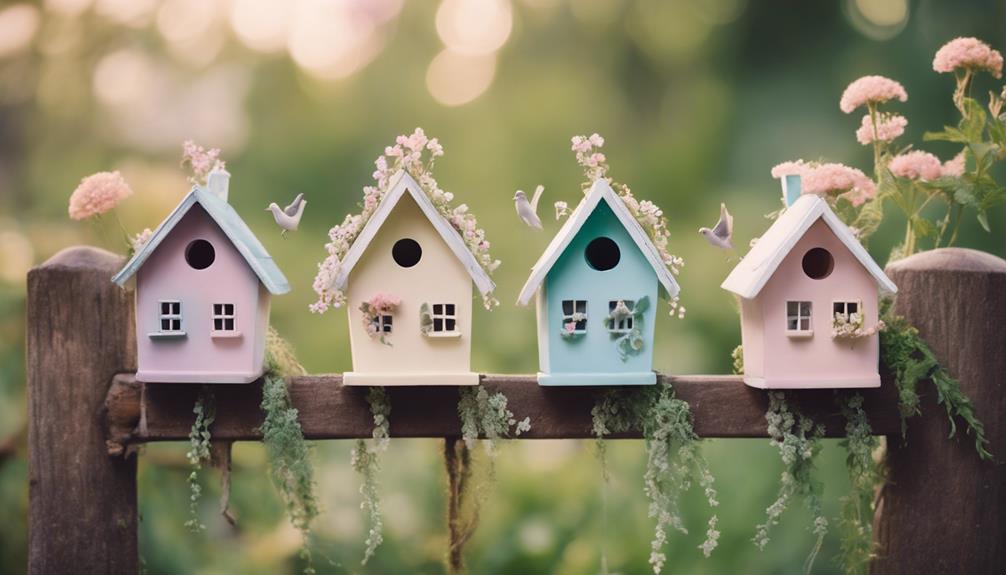
We can create charming spring cottage birdhouses with just a few simple crafting supplies from the dollar store. First, gather essential supplies like birdhouse kits, chalk paint, Mod Podge, and decorative paper. Then, paint the birdhouse base with Waverly chalk paint in agave, adding a vintage look with wax. Add decorative paper details using scrapbook paper and cardstock, and incorporate floral accents for a whimsical touch. Finally, assemble the cottage birdhouse by following the kit's instructions and adding personal touches. As we continue to craft, we'll explore more creative ways to customize our birdhouse and bring spring charm to our outdoor spaces.
Key Takeaways
• Use Dollar Tree birdhouse kits as a base for your spring cottage birdhouse project to save time and money.
• Apply Waverly chalk paint in vibrant colors to create a unique and charming look for your birdhouse.
• Add decorative paper details, such as scrapbook paper and cardstock, to give your birdhouse a touch of personality.
• Embellish your birdhouse with small floral accents, like colorful flowers and greenery, for a whimsical touch.
• Consider adding personal touches, like painting or decorating, to make your birdhouse truly one-of-a-kind.
Gathering Essential Crafting Supplies
As we start on this creative journey, we'll need to gather a few essential crafting supplies to transform our Dollar Store finds into charming spring cottage birdhouses. The first step is to collect the necessary materials, including birdhouse kits, which will serve as the base for our project.
Next, we'll need chalk paint in various colors to give our birdhouses a unique and personalized look. Additionally, we'll require Mod Podge, decorative cardstock, and scrapbook paper to add texture and visual interest to our creations. These supplies will allow us to apply multiple coats of paint, with drying time in between, to achieve a rich and vibrant color.
We'll also need white paint on hand for touch-ups and to create a cohesive look. By gathering these essential crafting supplies, we'll be well on our way to creating beautiful and unique spring cottage birdhouses that showcase our creativity and attention to detail.
Painting the Birdhouse Base
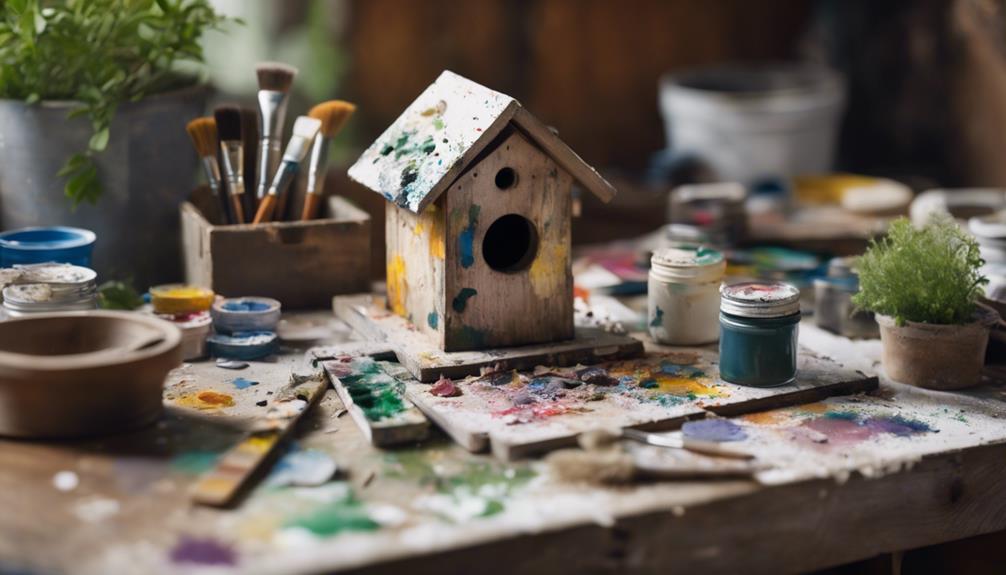
With our crafting supplies in hand, we're ready to bring our spring cottage birdhouses to life by painting the birdhouse base. This is where the magic happens, and our little birdhouses start to take shape.
To achieve a beautiful, solid base color, we'll apply two coats of Waverly chalk paint in agave, making sure that each coat dries completely before applying the next to prevent smudging or streaking.
Here are some essential tips to keep in mind:
- Use a small brush to touch up any areas that may have been missed or need extra coverage with white paint.
- Create a vintage look by applying wax over the dried paint, blending it in for a weathered effect.
- Maintain a smooth and even finish by taking your time and applying the paint and wax carefully to the birdhouse base.
Adding Decorative Paper Details
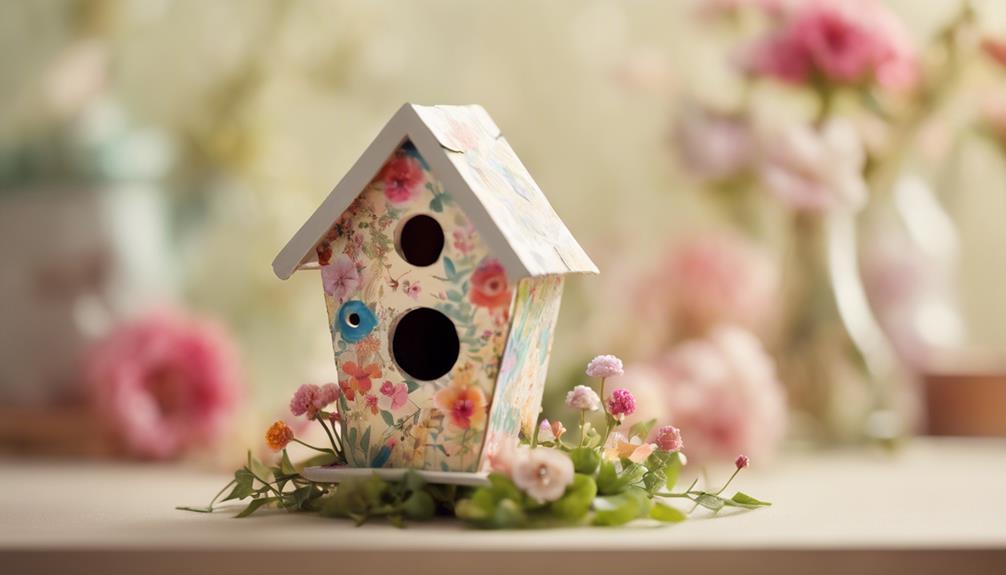
We're adding a personal touch to our spring cottage birdhouses by incorporating decorative paper details that infuse charm and character into these miniature homes. To guarantee this, we're using scrapbook paper and cardstock to create unique patterns and designs that reflect our personal style.
By mixing and matching different papers, we can create a cohesive and visually appealing final result. Next time, we might try adding rickrack trim or other embellishments to enhance the overall look of the birdhouse.
To make sure a secure hold, we'll attach the paper details using Mod Podge or glue. This technique is easy to master, and the results are well worth the effort.
With a little creativity, we can transform a plain birdhouse into a charming cottage that's full of personality. As we work on our birdhouses, we're reminded that it's the little details that make all the difference. By adding decorative paper details, we're creating a one-of-a-kind piece that's sure to delight.
Embellishing With Floral Accents
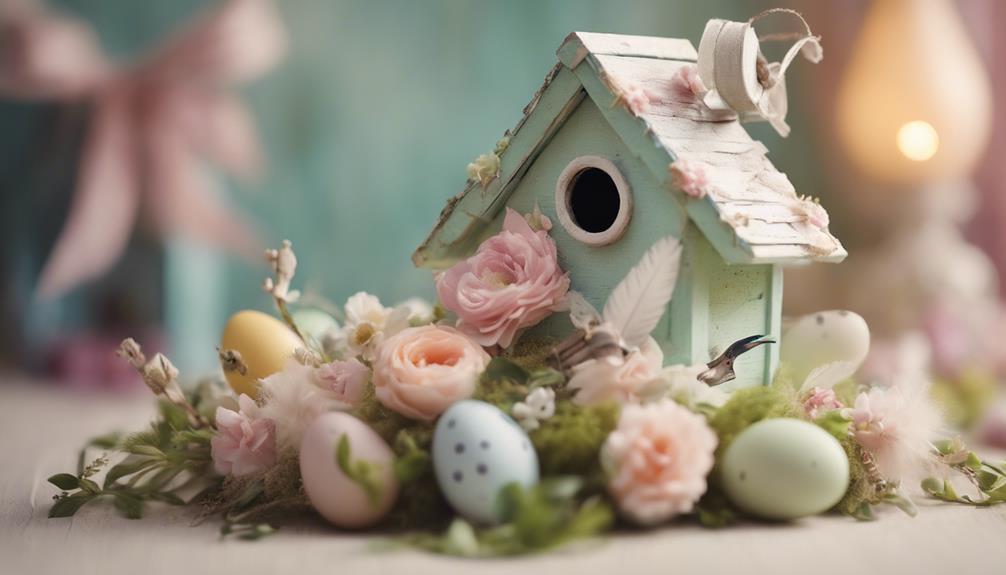
Now that we've added personality to our birdhouses with decorative paper details, let's take them to the next level by introducing a touch of whimsy with small floral accents.
We wanted to make our birdhouses stand out, and what better way to do that than with a splash of colorful flowers and greenery? To enhance our spring cottage birdhouses, we can use a variety of small flowers and foliage to create a natural and eye-catching look.
Here are some tips to keep in mind when embellishing with floral accents:
- Mix and match different flower shapes, sizes, and colors to create a visually appealing design.
- Consider using artificial flowers for a long-lasting and low-maintenance decorative option.
- Secure the floral accents with glue or adhesive to make certain they stay in place and withstand handling.
Assembling the Cottage Birdhouse
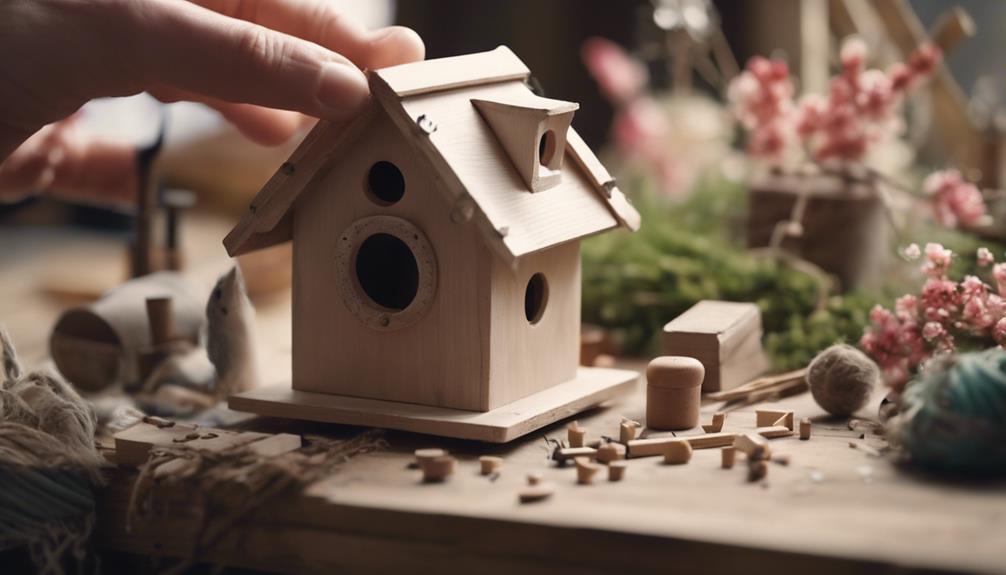
Let's get started on assembling our cottage birdhouse by following the instructions provided in the Dollar Tree birdhouse kit.
As we carefully read through the instructions, we'll make sure to pay attention to the finer details, such as aligning the roof and placing the windows correctly.
We'll use glue or nails to secure the pieces together, ensuring a sturdy construction that can withstand the elements.
As we assemble the birdhouse, we'll also think about adding our own personal touches, like painting or decorating, to make it truly unique.
If we're short on time, we can consider using a ready-made birdhouse from a craft store as an alternative.
Either way, we'll end up with a charming cottage birdhouse that's perfect for spring.
Frequently Asked Questions
Can I Use a Real Birdhouse Instead of a Wooden Birdhouse Shape?
We're wondering if we can ditch the wooden birdhouse shape and use a real birdhouse instead. Honestly, we think it's a great idea – it'll add a touch of authenticity to our DIY project!
Are There Any Alternatives to Decoupage Glue?
As we weave our creative tapestry, we ponder alternatives to decoupage glue, seeking a binding force that's strong yet gentle, like the threads of a spider's web. We find solace in mod podge, a trusty standby, or even white school glue, a humble hero.
How Do I Prevent the Paper Details From Peeling Off?
We prevent paper details from peeling off by applying a clear coat of varnish or Mod Podge after decoupage, ensuring a strong bond and protecting our artwork from wear and tear.
Can I Use Artificial Flowers Instead of Fresh Flowers?
We're wondering if artificial flowers are a viable substitute for fresh ones, and we think they're a great idea! They'll last longer and still add a pop of color, so go for it!
Is It Possible to Make This Project With Kids?
'As we dip our toes into the world of creativity, we ask: can little hands help craft this masterpiece? Absolutely! With patience and guidance, kids can contribute to this project, fostering a sense of pride and ownership.'
Conclusion
As we step back to admire our handiwork, our humble dollar store finds have been transformed into a charming spring cottage birdhouse, reminiscent of a 'hidden gem' tucked away in a lush garden.
The combination of soft hues and delicate details has yielded a whimsical retreat, beckoning birds to take up residence.
With a dash of creativity and some thriftiness, we've proven that beauty can indeed be found on a budget, as the saying goes, 'one person's trash is another person's treasure.'
Alfresco
Is an Alfresco a Verandah? Know the Difference!
Navigate the differences between an alfresco and a verandah to uncover which outdoor living space suits your needs best!
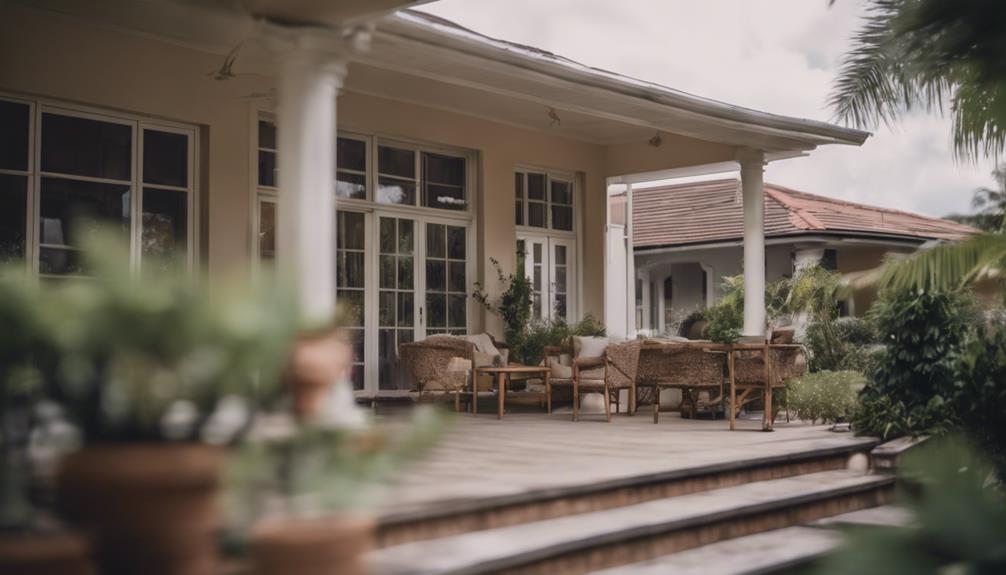
An alfresco and a verandah differ considerably in purpose and design. The alfresco serves as an outdoor dining extension under the main roof, while a verandah is ground-level, providing a covered area for relaxation. Alfrescos are oriented towards modern entertainment, include modern amenities, and attach to the main house's roof. Verandahs, on the other hand, are more traditional, overlooking the front of the house with a separate pitched roof. To explore further distinctions and choose wisely between an alfresco and a verandah, grasp their unique aspects and intended functionalities for your outdoor living needs.
Key Takeaways
- Alfresco serves as a modern outdoor dining and entertainment extension, while a verandah is a traditional covered space for relaxation.
- Alfrescos integrate with the main house roof and offer contemporary amenities, contrasting with verandahs' classic design elements.
- Alfrescos are ideal for outdoor dining year-round with modern finishes, while verandahs provide a sheltered area for socializing.
- Alfrescos use the main house roof for shade and are attached to the house, while verandahs have standalone covered roofs.
- Alfrescos prioritize modern materials like glass and steel for a sleek appearance, while verandahs typically use traditional materials like timber.
Alfresco Area Vs Verandah: Key Contrasts
When comparing an alfresco area to a verandah, the key contrasts lie in their design and intended use. An alfresco area serves as an outdoor extension for dining under the main roof, providing a space for casual meals and gatherings.
On the other hand, a verandah is a covered structure at ground level that connects front and back entrances, offering a place for relaxation and socializing in a traditional architectural style.
The alfresco area is specifically designed for outdoor dining and entertainment, often equipped with sliding doors for protection and to enhance the aesthetic value of a home. In contrast, verandahs are used for small parties and overlook the front of the house, providing a covered area to enjoy the outdoors while being protected from the elements.
While alfrescos seamlessly extend the home's living space, verandahs act as a connection space between indoor and outdoor areas. The alfresco area is commonly associated with modern outdoor living, while verandahs offer a more traditional touch to the architectural design of a house.
Design Variances Between Alfresco and Verandah
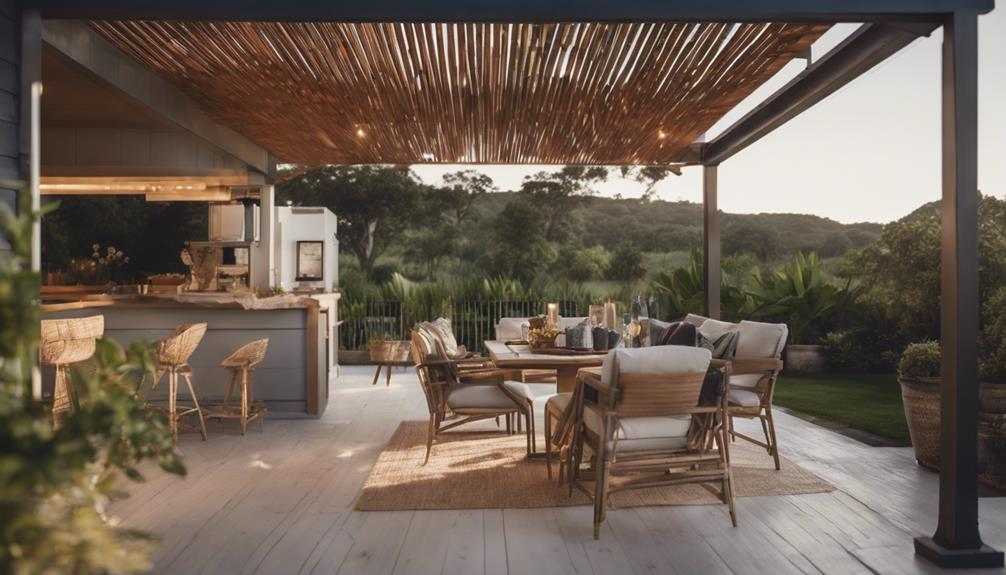
When comparing the design variances between an alfresco and a verandah, it's important to analyze the roof structures, functional spaces, and material selections. The roof structure of an alfresco tends to be integrated into the main house roof, creating a seamless indoor-outdoor flow, while verandahs often feature a separate pitched roof design.
Functional space variations highlight how alfrescos are tailored for dining and entertaining, whereas verandahs serve as sheltered passageways around the house, emphasizing a historical architectural connection.
Material selection variances further distinguish these outdoor spaces, with alfrescos featuring modern amenities and finishes, contrasting with the classic design elements of verandahs.
Roof Structure Differences
In distinguishing between alfrescos and verandahs, one key aspect that sets them apart is their roof structures. Alfrescos typically utilize the main roof of the house for shade, blending seamlessly with the existing architecture. On the other hand, verandahs are standalone covered structures at ground level, having their own distinct roof separate from the main house. To help visualize the differences, refer to the table below:
| Aspect | Alfresco | Verandah |
|---|---|---|
| Location | Attached to the main house | Standalone structure at ground level |
| Roof Structure | Uses the main roof for shade | Has its own covered roof |
| Purpose | Outdoor dining under existing roof | Connects front and back entrances of a home |
| Design | Integrates with house design | Traditional connecting space |
| Size | Often smaller, part of the main structure | Longer and narrower for small gatherings |
Understanding these distinctions can assist in making informed decisions when considering the addition of either an alfresco or a verandah to your property.
Functional Space Variations
For understanding the design variances between an alfresco and a verandah, consider their functional space variations. An alfresco is an outdoor extension of the main living area, designed for modern features like outdoor kitchens and dining areas. It serves as a covered structure, offering protection from the elements year-round and can be partially enclosed for added comfort.
In contrast, a verandah is a more traditional covered structure attached along the front, back, or side of a house, serving as a space between indoors and outdoors. Verandahs are open structures that provide shade and a relaxing outdoor space. Alfrescos are commonly used for outdoor dining and entertaining purposes, while verandahs are ideal for relaxing, reading, or enjoying the surrounding landscape views.
While alfrescos are typically built as extensions of the home under the main roof, verandahs can be freestanding or attached structures with various roof options like flat, skillion, or gable roofs.
Material Selection Variances
If you're considering the design variances between an alfresco and a verandah, the material selection plays an essential role in distinguishing these outdoor living spaces. Alfrescos often incorporate modern materials like glass and steel, giving them a contemporary feel, while verandahs typically utilize traditional materials such as timber for a more classic appearance.
When it comes to design elements, verandahs may include decorative features like fretwork or balustrades for elegance, whereas alfrescos focus on sleek, functional designs. Prioritizing weather resistance and durability, alfrescos commonly use materials like aluminum and composite decking, contrasting with verandahs that may opt for hardwoods like cedar or merbau to achieve a natural aesthetic.
Additionally, alfrescos may integrate high-tech materials like UV-resistant polycarbonate roofing and composite cladding for low maintenance, setting them apart from the more rustic feel of verandahs. The choice of materials significantly impacts the overall style, maintenance needs, and longevity of these outdoor spaces.
Functional Disparities of Alfresco and Verandah
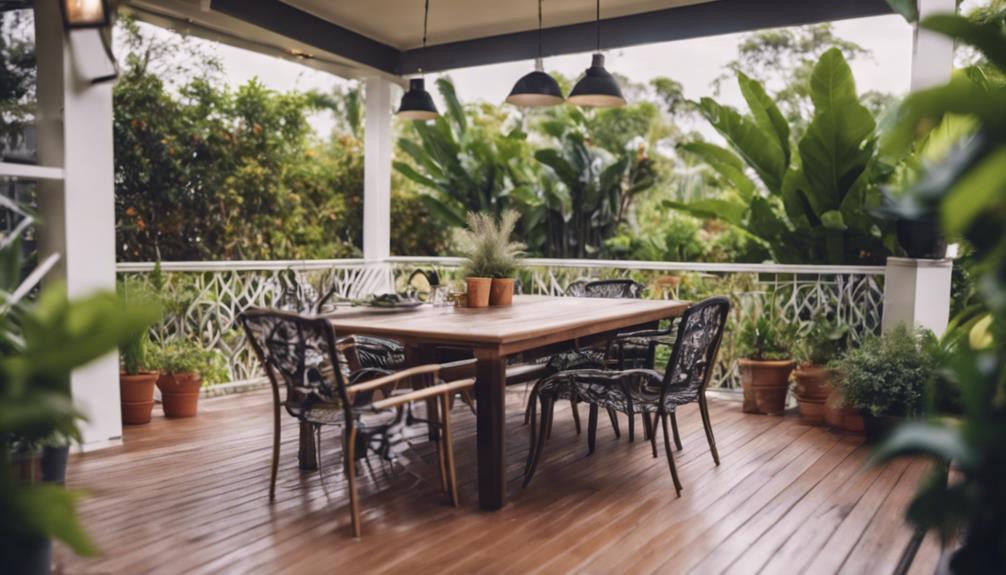
An alfresco and a verandah serve distinct functions within a home, showcasing usage variations and design elements that differentiate the two structures.
Alfrescos are designed to create an integrated outdoor living space under the main roof, often equipped with amenities like outdoor kitchens, ideal for dining and entertainment.
In contrast, verandahs act as covered passageways or social spaces, offering a connecting area between the indoors and outdoors, commonly used for relaxation or to enjoy the front view of the house.
Usage Variations
The functional disparities between alfrescos and verandahs are evident in their distinct usage variations. Alfrescos are primarily designed for outdoor dining and entertaining, creating a space for leisure activities and social gatherings. They offer a seamless extension of the indoor living space, blurring the lines between indoor and outdoor areas. Alfrescos often come equipped with amenities like outdoor kitchens and dining areas to enhance the overall experience.
On the other hand, verandahs serve a simpler purpose, acting as covered pathways or connecting areas within a home. They're typically used for small gatherings or as a relaxation spot, providing shelter and linking different parts of the house. Verandahs prioritize functionality over elaborate design features, focusing on their role as a covered structure rather than a dedicated entertainment space.
Essentially, while alfrescos cater to outdoor living and dining experiences, verandahs serve as practical connectors within a property.
Design Elements
When comparing the design elements of alfrescos and verandahs, it becomes evident that they serve distinct functional purposes in enhancing outdoor living spaces. Alfrescos are designed as outdoor extensions for dining under the main roof, providing a smooth shift between indoor and outdoor areas. They focus on creating a smooth flow, using the main roof for shade and offering protection from the elements year-round. These covered structures not only enhance the aesthetic value of a home but also cater to outdoor dining and entertainment needs.
On the other hand, verandahs are typically at ground level, overlooking the front or back of a house, and are more commonly used for relaxing or enjoying the outdoor view. Their design elements revolve around providing a covered pathway or sitting area. While alfrescos emphasize smooth shifts and outdoor extensions, verandahs prioritize offering a covered space for various activities, albeit with a different aesthetic appeal.
Comparing Alfresco and Verandah Aesthetics
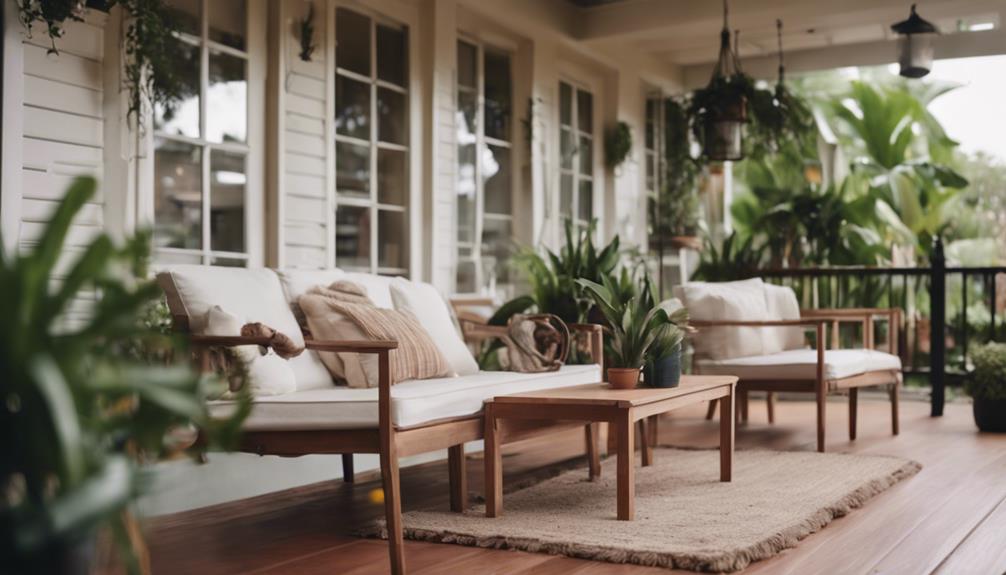
Alfrescos and verandahs present distinct aesthetics that showcase their unique design features and styles. While alfrescos lean towards a modern and sleek appearance, verandahs exude a more traditional and classic charm. The table below highlights some key differences in the aesthetics of alfrescos and verandahs:
| Aspect | Alfresco | Verandah |
|---|---|---|
| Roof Design | Often a part of the main roof structure | Separate roof covering the structure |
| Supporting Columns | Minimal or absent | Typically adorned with columns or posts |
| Architectural Style | Contemporary | Traditional |
Alfrescos tend to prioritize a seamless integration of indoor and outdoor spaces, often featuring sliding doors and a modern appeal. In contrast, verandahs boast a more timeless look with prominent columns and a roof that extends from the main structure. These differences in design elements contribute to the overall aesthetic and feel of each outdoor living space.
Alfresco Vs Verandah: Usage Distinctions
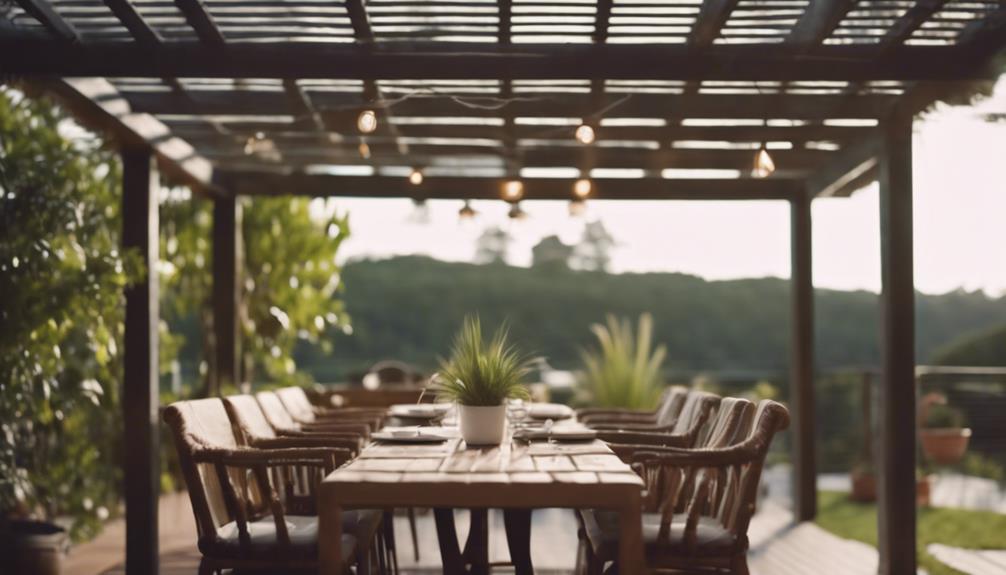
Highlighting the versatile functionality of outdoor living spaces, alfrescos and verandahs offer distinct usage distinctions that cater to different preferences and needs.
Here are some key differences to help you understand how alfrescos and verandahs are used:
- Alfresco:
- An alfresco is an outdoor extension primarily designed for dining under the main roof.
- It enhances the aesthetic appeal of a home and often includes sliding doors for protection during various weather conditions.
- Alfrescos are typically associated with outdoor dining and entertaining spaces, providing a cozy and inviting atmosphere for gatherings.
- Verandah:
- In contrast, a verandah is a covered ground-level structure that connects the front and back entrances of a house.
- Verandahs can be utilized for small gatherings or as relaxing spots overlooking the front of the house.
- They serve as covered pathways or sitting areas along the perimeter of a property, facilitating easy shifts between indoor and outdoor spaces.
Structural Differences: Alfresco Vs Verandah
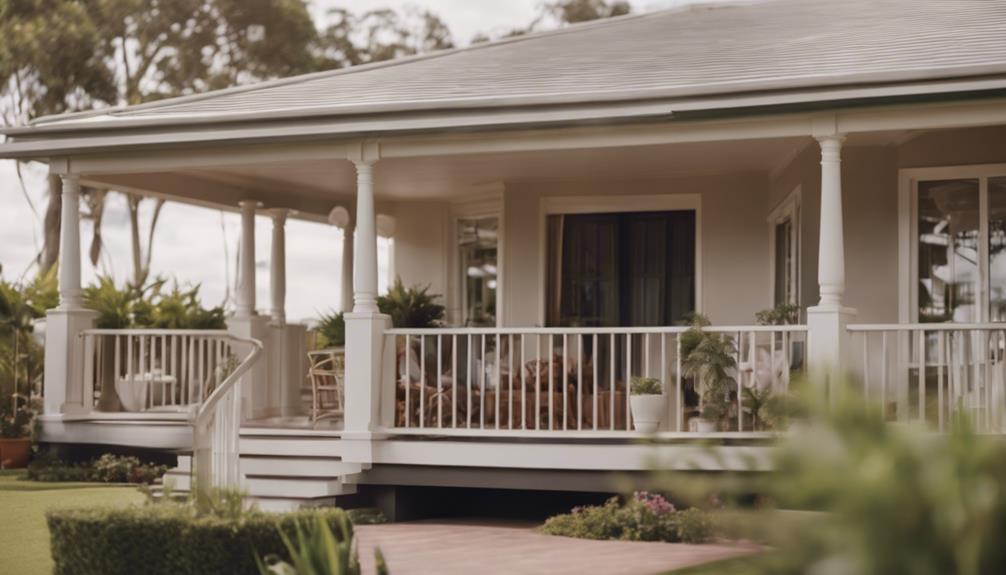
When comparing an alfresco to a verandah, structural differences are evident in the roofing materials used and the level of enclosure. Alfrescos typically feature roofs that are extensions of the main house structure, providing a high level of enclosure with sliding doors for protection.
Verandahs, on the other hand, may have different roofing materials and offer a more open design, often acting as covered walkways or sitting areas.
Roofing Materials Used
Utilizing the main roof of the house for support, alfrescos commonly employ roofing materials such as Colorbond steel or insulated panels. Verandahs, on the other hand, often feature independent roofing materials like corrugated iron or timber shingles.
When considering the roofing materials used in alfrescos and verandahs, several key differences emerge:
- Integration with the Main House: Alfrescos tend to integrate more seamlessly with the main house due to their shared roofing materials, creating a cohesive look. In contrast, verandahs offer a distinct aesthetic appeal by utilizing independent roofing materials.
- Aesthetic Variation: The choice of roofing material for alfrescos or verandahs can have a notable impact on the overall aesthetic of the outdoor structure. Colorbond steel exudes a modern and sleek appearance, while timber shingles provide a more traditional and rustic look.
- Durability and Maintenance: The selection of roofing materials also influences the durability and maintenance requirements of alfrescos and verandahs. Insulated panels offer enhanced insulation and energy efficiency for alfrescos, whereas corrugated iron may require more frequent maintenance for verandahs.
Level of Enclosure
For a clear distinction between an alfresco and a verandah regarding structural differences, consider the level of enclosure each outdoor space provides. An alfresco is typically more enclosed than a verandah, offering walls or privacy screens that provide a sense of coziness and protection. This enclosed structure allows for year-round use, shielding you from the elements while enjoying outdoor dining or entertainment. On the other hand, a verandah is more open, serving as a covered passage from indoors to outdoors. Verandahs are commonly used for relaxation and admiring the surroundings, creating a welcoming entry to your home. To better understand the differences, let's take a look at the comparison table below:
| Aspect | Alfresco | Verandah |
|---|---|---|
| Level of Enclosure | Enclosed with walls or screens | More open with less enclosure |
| Year-round Use | Suitable for all seasons | May be less comfortable in extreme weather |
| Protection | Offers protection from elements | Provides minimal shelter from weather |
| Outdoor Dining | Ideal for outdoor dining experiences | Can be used for light meals or relaxation |
| Entertainment | Great for hosting gatherings and events | Suitable for relaxing and enjoying views |
Alfresco or Verandah: Which to Choose?
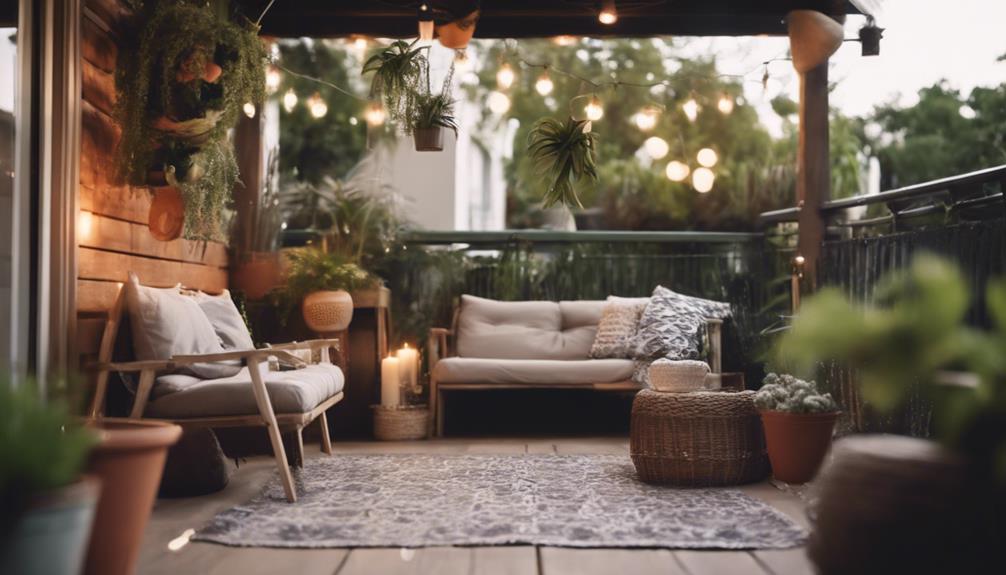
Considering whether to opt for an alfresco or a verandah for your outdoor space can depend on your lifestyle preferences and desired functionality. Both options have their unique characteristics that cater to different needs. Here are some key points to help you make an informed decision:
- Functionality:
- Alfrescos are ideal for adding an outdoor living space that seamlessly connects to your home, perfect for dining and entertaining.
- Verandahs provide a covered area that serves as a connecting space between the indoors and outdoors.
- Design:
- Alfrescos often feature outdoor kitchens, dining areas, and furniture, enhancing the outdoor living experience.
- In contrast, verandahs offer a covered space for relaxation or small gatherings.
- Purpose:
- While alfrescos focus on expanding your living area outdoors, verandahs primarily function as covered walkways or sitting areas.
Consider your lifestyle needs and desired functionality to determine which option best suits your home.
Outdoor Living: Alfresco Vs Verandah
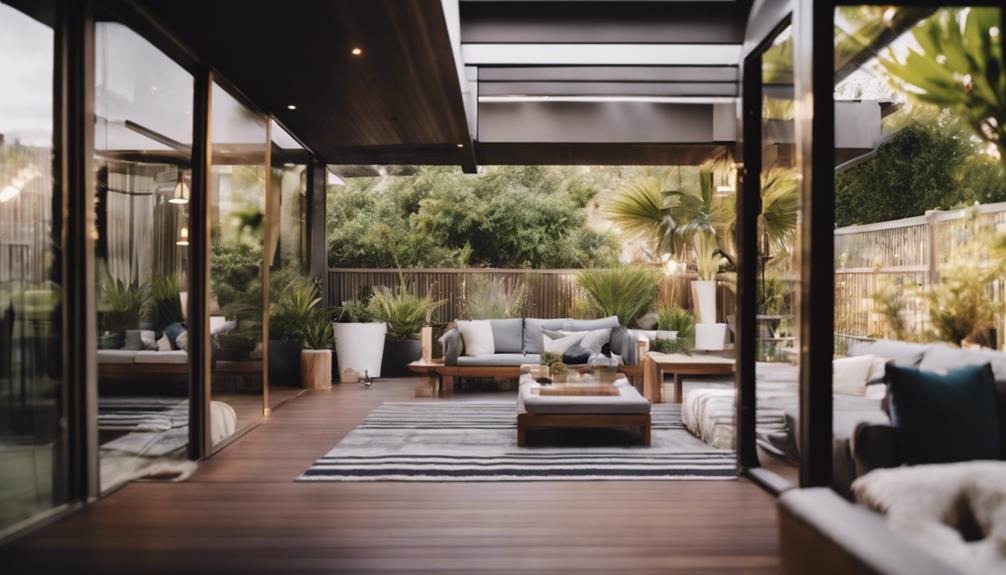
When considering your outdoor living space, it's crucial to understand the specific characteristics of each option. Below is a comparison table highlighting key differences between an alfresco and a verandah:
| Aspect | Alfresco | Verandah |
|---|---|---|
| Location | Connected to the main house | Along the front, back, or side of the house |
| Purpose | Designed for dining and entertaining | Serves as a connecting space between indoors and outdoors |
| Integration | Offers a seamless look with the main house | Can vary in size and shape |
| Features | Often includes sliding doors for protection | Typically has open sides for ventilation |
| Function | Enhances the aesthetic value of the home | Provides a covered area for relaxation and social gatherings |
Understanding these distinctions can help you make an informed decision when planning your outdoor living space.
Alfresco Vs Verandah: Home Value Impact
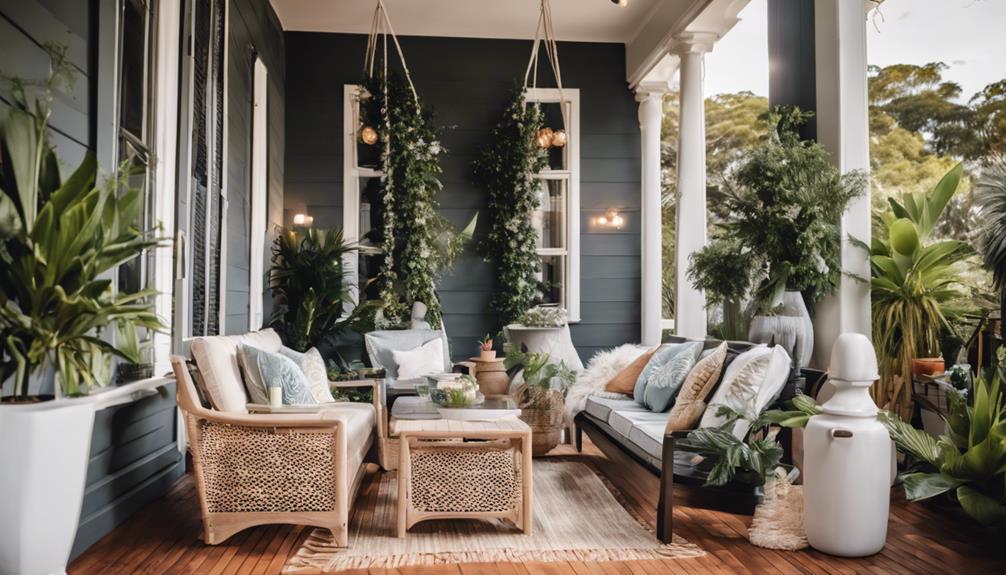
Understanding the impact on home value between an alfresco and a verandah is key when planning your outdoor living space. When considering whether to add an alfresco or a verandah to your home, here are some key points to keep in mind:
- Home Value Increase: Adding an alfresco can potentially raise your home's value by up to 20%, making it a lucrative investment for homeowners looking to increase their property's worth.
- Traditional Charm vs. Modern Appeal: While a verandah typically adds 12-15% to the value of a home, alfrescos are perceived as more modern and luxurious. The choice between the two can depend on whether you prefer traditional charm or modern appeal.
- Buyer Attraction: Both alfrescos and verandahs can enhance curb appeal and attract potential buyers. However, alfrescos, being more contemporary, might have a broader appeal to a modern buyer demographic.
Making the Choice: Alfresco or Verandah
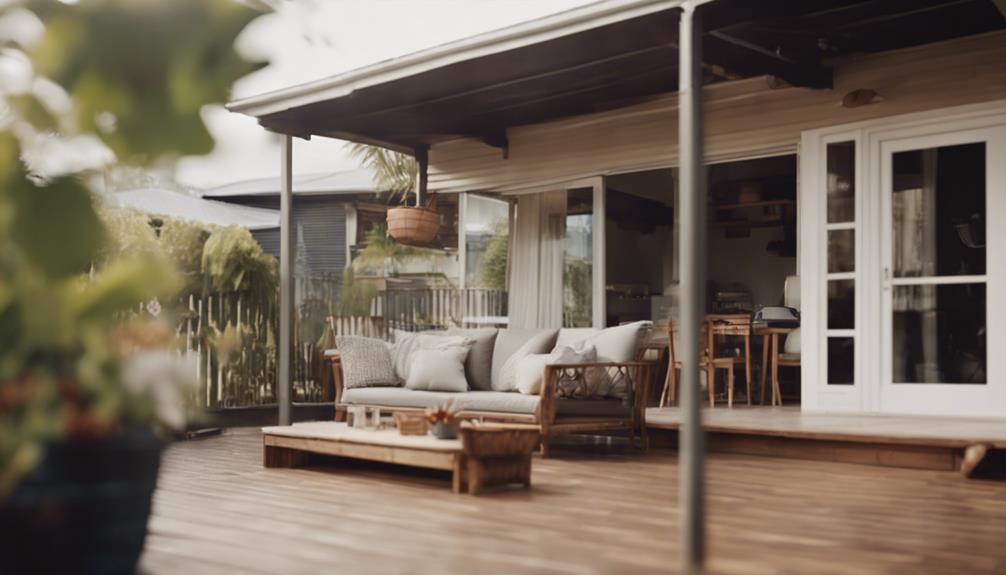
When deciding between an alfresco and a verandah for your outdoor space, consider the primary function and desired aesthetic appeal of each option.
An alfresco is an outdoor living space connected to the main house, offering protection from the elements and customizable features like outdoor kitchens for dining and entertaining.
On the other hand, a verandah is a covered structure typically attached to the front, back, or side of a house, serving as a connecting space between indoors and outdoors, ideal for relaxation and enjoying the view.
The choice between an alfresco and a verandah depends on the function you envision for your outdoor living space. If you prioritize seamless integration with your main house and desire a space for hosting gatherings and meals, an alfresco might be the ideal option.
Conversely, if you seek a covered area for unwinding and appreciating the surroundings, a verandah could better suit your needs. Evaluate your preferences, location, and design goals to make an informed decision that complements your outdoor lifestyle.
Frequently Asked Questions
What Is Considered a Verandah?
When considering what is considered a verandah, think of a covered structure attached to a house, offering a sheltered outdoor space. It serves as an extension of the main roof, providing a cozy connection to the outdoors.
What Is the Difference Between a Veranda and a Verandah?
When distinguishing between a veranda and a verandah, note that they both provide covered outdoor spaces attached to a house. The key difference lies in spelling variations, with "veranda" being more common internationally and "verandah" in Australia.
What Is an Alfresco on a House?
An alfresco on a house is an outdoor living area designed for dining and entertaining. It seamlessly connects indoor and outdoor spaces under the main roof. Alfrescos provide protection from the elements and a cozy ambiance.
Is a Pergola and Verandah the Same Thing?
A pergola and a verandah are not the same thing. A verandah is attached to the main house with a covered roof, while a pergola stands freely with an open slatted roof for climbing plants.
Conclusion
In the end, choosing between an alfresco area and a verandah comes down to personal preference and lifestyle needs. Each option offers distinct design, functionality, and aesthetic features that cater to different outdoor living experiences.
Whether you opt for the open-air appeal of an alfresco or the traditional charm of a verandah, both can enhance your home's value and provide a delightful space for relaxation and entertainment. Make your choice wisely to create the perfect outdoor oasis for your home.
-

 Craft and Textiles2 months ago
Craft and Textiles2 months ago15 Best Places to Buy Appliances for Your Home – Top Retailers Reviewed
-

 Vetted3 weeks ago
Vetted3 weeks ago14 Best Personalized Father's Day Gifts for Your Husband – Show Him You Care
-

 Decorative Throws2 months ago
Decorative Throws2 months agoIs It Better to Dry Clean Blankets?
-

 Yarn2 months ago
Yarn2 months agoIs Yarn Natural or Manmade? Unravel the Truth
-

 Tableware and Dining Accessories2 months ago
Tableware and Dining Accessories2 months agoWhat Is the Meaning of the Word Tableware
-

 Tableware and Dining Accessories2 months ago
Tableware and Dining Accessories2 months agoWhat Is the Hindi Meaning of Tableware
-

 Craft and Textiles2 months ago
Craft and Textiles2 months ago15 Best Cordless Mowers for Effortless Lawn Care – Top Picks of 2024
-

 Craft and Textiles2 months ago
Craft and Textiles2 months ago15 Best Battery-Powered Leaf Blowers for Effortless Yard Work


















